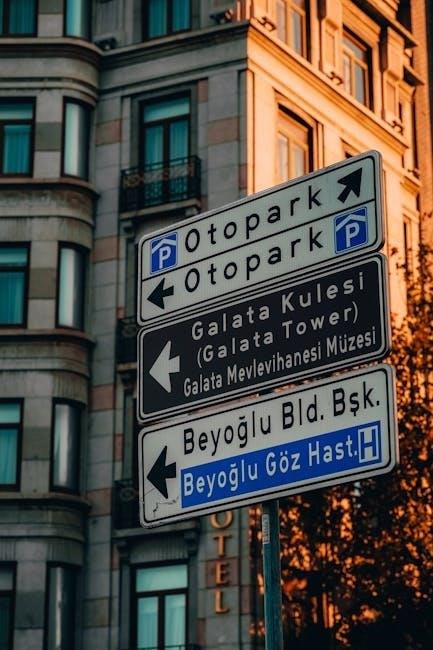
Welcome to our comprehensive guide on parking! This section introduces you to the basics of parking, covering essential techniques, safety tips, and common challenges. Learn how to master various parking types, ensuring confidence and safety behind the wheel. Proper parking is crucial for avoiding accidents and adhering to traffic rules. Whether you’re a beginner or seeking to refine your skills, this guide provides step-by-step instructions and expert advice to help you park like a pro.
1.1 Importance of Proper Parking
Proper parking is essential for safety, as it prevents accidents and ensures clear traffic flow. It also helps avoid fines from parking violations and reduces the risk of vehicle damage. Correct parking etiquette maintains order in parking areas and demonstrates respect for other drivers. Mastering proper parking techniques builds confidence and ensures compliance with traffic rules, making driving experiences smoother and stress-free for everyone involved.
1.2 Overview of Parking Types
Parking types include parallel, angled, and perpendicular parking, each suited for different spaces and locations. Parallel parking is ideal for street-side spots, while angled parking is common in lots with slanted spaces. Perpendicular parking offers compact, grid-style arrangements, maximizing space in busy areas. Understanding these types ensures efficient use of available parking spaces and adapts to various urban and suburban environments effectively.

Types of Parking Spots
Parking spots vary in design, including parallel, angled, and perpendicular spaces. Each type is tailored for specific locations, ensuring efficient use of urban and suburban areas while maintaining traffic flow smoothly.
2.1 Parallel Parking
Parallel parking is a common urban challenge, requiring precision to align your vehicle within a narrow space between two cars. Start by signaling and stopping parallel to the car in front of the empty space. Reverse slowly, turning your wheels fully to the right once your bumper aligns with the rear of the front car. Check your mirrors and blind spots for obstacles. As your vehicle enters the space, straighten your wheels to center yourself. Continue reversing until your car is evenly spaced and within the lines. Practice this technique in less busy areas to build confidence and accuracy.
2.2 Angled Parking
Angled parking involves driving into a space at a diagonal, commonly found in lots with slanted lines. Approach the space at a 45-degree angle, aligning your vehicle with the center of the parking line. Check your mirrors and blind spots for clearance. Once your bumper aligns with the space’s front edge, straighten your wheels to center the car. Adjust as needed to fit neatly within the lines, ensuring safe distance from neighboring vehicles. This method is efficient for drivers in busy areas, offering a quicker turnaround compared to parallel parking. Practice angled parking to enhance your spatial awareness and maneuvering skills.
2.3 Perpendicular Parking
Perpendicular parking involves parking your car at a right angle to the parking space, typically in lots with straight rows. Identify a suitable space, position your vehicle straight, and slow down. Align your car with the parking lines, then turn your wheels to center within the space. Check mirrors and blind spots for clearance, ensuring you don’t obstruct neighboring vehicles. Adjust as needed for proper alignment, making sure your car fits neatly within the marked lines. This method is ideal for larger parking areas and requires attention to spatial awareness and precision steering. Practice perpendicular parking to improve your ability to maneuver in structured lots.

Parking Techniques
Parking techniques are essential for safe and efficient vehicle placement. Straight parking involves aligning directly into a space, while reverse parking requires precision and awareness of surroundings. Mastering these methods ensures confident maneuvering in various parking scenarios, enhancing overall driving skills and reducing accidents. Practice these techniques regularly to improve accuracy and control.
3.1 Straight Parking
Straight parking involves aligning your vehicle directly into a space. Position your car centrally, check mirrors, and maintain a steady speed. Aligning your car correctly ensures easy exit and avoids obstructions. This method is ideal for beginners, as it minimizes complexity. Practice straight parking to build confidence and improve spatial awareness, essential for more challenging techniques like parallel parking.
3.2 Reverse Parking
Reverse parking involves backing into a space, often used in perpendicular or angled spots. Stop a car’s length away, signal, and shift into reverse. Check mirrors and surroundings, then align your bumper with the space. Move slowly, maintaining control, and straighten once aligned. Use parking sensors or cameras for accuracy. Always stay alert, even with modern aids, to ensure safety and precision while reversing into tight spaces.
Safety Tips for Parking
Ensure safety by checking surroundings, signaling clearly, and maintaining distance. Be cautious in tight spaces and always prioritize visibility and awareness while parking.
4.1 Maintaining Distance from Other Vehicles
Maintaining proper distance from other vehicles is crucial for safety. Always check your mirrors and blind spots before maneuvering. Ensure there’s enough space to avoid collisions. When parking, align your car straight and leave adequate gaps to prevent damage. Avoid squeezing into tight spots, as this can obstruct traffic or lead to accidents. Practice gauging distances accurately for confident parking.
4.2 Aligning Your Vehicle Correctly
Proper alignment is key to safe and efficient parking. Position your car straight within the space, using landmarks or lines as guides. Avoid tilting or angling, as this can lead to collisions or obstruct neighboring vehicles. Check mirrors and blind spots to ensure accurate positioning. Adjust your wheels and body alignment slowly, maintaining focus on the space and surrounding cars for precise placement.
4.3 Awareness of Surroundings
Awareness of your surroundings is crucial for safe parking. Always check mirrors, blind spots, and nearby obstacles. Look out for pedestrians, bicycles, and other vehicles. Use backup cameras and parking sensors to detect objects behind and around your car. Stay alert to avoid collisions and ensure a smooth parking experience. Distractions can lead to accidents, so remain focused and cautious throughout the process.
Common Parking Challenges
Parking can present challenges like tight spaces and poor weather conditions. These require skill, patience, and attention to detail to navigate safely and effectively.
5.1 Tight Parking Spaces
Tight parking spaces require precise maneuvering and careful alignment. Measure the space to ensure your vehicle fits, then position it at an angle. Use mirrors and cameras for visibility. Slowly guide your car into the spot, checking distances on all sides. Avoid rushing, as small movements are key. Practice in empty lots to build confidence in navigating tight spaces effectively.
5.2 Parking in Poor Weather Conditions
Parking in poor weather demands extra caution due to reduced visibility and slippery surfaces. Use low beams in fog or rain to avoid blinding others. In snowy or icy conditions, slow down and avoid sudden movements. Maintain a safe distance from other vehicles and use parking aids like cameras or sensors if available. Always prioritize safety over speed.

Parking Aids and Technology
Modern parking aids like backup cameras, sensors, and guided systems simplify parking. These technologies enhance accuracy, reduce stress, and help drivers navigate tight spaces confidently.
6.1 Backup Cameras
Backup cameras provide a clear rear view, enhancing visibility when reversing. They reduce blind spots, making parking safer and easier, especially in tight spaces. Many vehicles now feature built-in cameras, while others can be equipped with aftermarket solutions. These cameras often include guidelines to help drivers align their car properly with the parking space, minimizing the risk of collisions and improving overall parking accuracy.
6;2 Parking Sensors
Parking sensors enhance safety by detecting obstacles around your vehicle. Using ultrasonic technology, they alert drivers to nearby objects through audible or visual signals. These sensors are particularly useful in tight spaces, reducing the risk of collisions. Modern systems often combine multiple sensors for 360-degree coverage, while some integrate with cameras for a comprehensive parking experience, ensuring accuracy and confidence when maneuvering.
Legal Considerations
Understand local parking laws to avoid fines or towing. Adhere to no-parking zones, time limits, and permit requirements. Always check signage for specific regulations before parking.
7.1 No Parking Zones
No parking zones are areas where parking is strictly prohibited. These zones are clearly marked with signs and may be enforced at specific times. Ignoring these restrictions can result in fines, towing, or vehicle impoundment. Always check for no parking signs before leaving your vehicle to avoid legal consequences and ensure smooth traffic flow. Obeying these rules is essential for road safety and compliance with local laws.
7.2 Time Limits and Parking Tickets
Time limits for parking are set to manage space availability and traffic flow. Exceeding these limits can result in parking tickets, fines, or even towing. Always check posted signs for duration restrictions and payment requirements. Pay meters or permits as needed to avoid penalties. Adhering to time limits ensures compliance with local regulations and helps maintain orderly parking systems.

Parking Lot Etiquette
Parking lot etiquette enhances the overall parking experience. Always respect other drivers, avoid obstructing lanes, and park within designated lines. Courtesy ensures a smooth flow of traffic and reduces congestion, making parking more efficient and stress-free for everyone. Adhering to these unwritten rules fosters a considerate environment for all users.
8.1 Respecting Other Drivers
Respecting other drivers is essential for harmonious parking experiences. Always signal your intentions, yield to approaching vehicles, and avoid cutting off others. Patience is key—wait for your turn and never rush. Be mindful of pedestrians and maintain a safe distance from moving cars. Courtesy gestures like waving or acknowledging others foster a positive atmosphere in parking lots, ensuring everyone’s safety and comfort. Proper etiquette reduces stress and promotes cooperative behavior among all road users. By being considerate, you contribute to a smoother and more pleasant parking environment for everyone involved. This approach not only prevents conflicts but also enhances overall driving manners. Remember, a little kindness goes a long way!
8.2 Avoiding Obstructions
Avoiding obstructions in parking lots ensures smooth traffic flow and prevents accidents. Always position your vehicle within the marked lines to maintain clear pathways for others. Check your mirrors and blind spots to ensure you’re not blocking pedestrian walkways or adjacent parking spaces. Leaving adequate space around your car helps other drivers maneuver safely. Proper alignment and positioning prevent obstructions, fostering a stress-free parking environment for everyone. Remember, thoughtful parking promotes harmony and efficiency in shared spaces, reducing congestion and enhancing overall accessibility. By being mindful of your vehicle’s placement, you contribute to a safer and more organized parking experience for all drivers and pedestrians alike. This considerate approach minimizes delays and ensures everyone can park and move without hindrance. Proper parking etiquette is essential for maintaining order in busy areas, and avoiding obstructions is a key part of this. Always be aware of your surroundings and park responsibly to avoid causing inconvenience to others. This not only enhances your own parking experience but also improves the overall flow of traffic in parking lots. By taking the time to park correctly, you help create a more pleasant environment for everyone using the facility. Additionally, avoiding obstructions reduces the risk of accidents and potential damage to vehicles, making it a crucial aspect of responsible driving. Always strive to park in a way that respects the space of others and adheres to parking guidelines. This thoughtful approach ensures that parking lots remain safe, efficient, and user-friendly for all drivers. Proper parking practices are everyone’s responsibility, and avoiding obstructions is a fundamental part of these practices. By doing your part, you help maintain a positive and courteous parking environment for everyone involved. This not only reflects well on you as a driver but also contributes to the overall safety and functionality of parking areas. Always remember that parking is not just about finding a spot but also about doing so in a way that respects others and follows established rules. Avoiding obstructions is a simple yet effective way to achieve this, ensuring that parking lots remain accessible and convenient for all users. Through careful planning and attention to detail, you can play a significant role in creating a better parking experience for everyone. So, always take the extra moment to ensure your vehicle is parked in a way that avoids obstructions and promotes a smooth flow of traffic. This small effort can make a big difference in the overall efficiency and safety of parking facilities. By avoiding obstructions, you help create a more enjoyable and stress-free parking experience for yourself and those around you. This is an important aspect of parking etiquette that should never be overlooked. Always prioritize responsible parking practices to contribute positively to the shared spaces we all use. Remember, parking is not just about securing a spot for your vehicle but also about being considerate of others and maintaining a safe environment for everyone. Avoiding obstructions is a key component of this, and by adhering to this principle, you help ensure that parking lots remain functional and enjoyable for all drivers. This approach not only enhances your own parking experience but also supports the overall efficiency and safety of the facility. By taking the time to park thoughtfully and avoid obstructions, you contribute to a more orderly and respectful parking environment. This is essential for maintaining the smooth operation of parking lots and ensuring that everyone can park without unnecessary challenges or delays. Always keep in mind the impact of your parking habits on others and strive to avoid obstructions in all situations. This is a fundamental aspect of parking etiquette that promotes cooperation and mutual respect among drivers; By avoiding obstructions, you help create a more positive and efficient parking experience for everyone involved. This is a simple yet powerful way to make a difference in the way parking lots function and the way people interact within these spaces. Always remember that parking is a shared responsibility, and avoiding obstructions is a crucial part of fulfilling your role as a responsible driver. By doing so, you contribute to a safer, more organized, and more courteous parking environment for all. This is not only beneficial for others but also enhances your own parking experience by reducing stress and potential hazards. Avoiding obstructions is a win-win for everyone involved, and it is an essential practice that should be embraced by all drivers. By taking this approach, you help create a parking environment that is both efficient and enjoyable, where everyone can park without unnecessary challenges or delays. Remember, parking is not just about finding a spot but also about doing so in a way that respects the space and safety of others. Avoiding obstructions is a key part of this, and by prioritizing it, you contribute to a better parking experience for all users. This is a simple yet effective way to make a positive impact on the way parking lots operate and the way people interact within them. Always strive to park in a way that avoids obstructions and promotes a smooth flow of traffic. This thoughtful approach ensures that parking lots remain safe, efficient, and user-friendly for everyone. By avoiding obstructions, you help create a more enjoyable and stress-free parking experience for yourself and those around you. This is an important aspect of parking etiquette that should never be overlooked. Always prioritize responsible parking practices to contribute positively to the shared spaces we all use. Remember, parking is not just about securing a spot for your vehicle but also about being considerate of others and maintaining a safe environment for everyone. Avoiding obstructions is a key component of this, and by adhering to this principle, you help ensure that parking lots remain functional and enjoyable for all drivers. This approach not only enhances your own parking experience but also supports the overall efficiency and safety of the facility. By taking the time to park thoughtfully and avoid obstructions, you contribute to a more orderly and respectful parking environment. This is essential for maintaining the smooth operation of parking lots and ensuring that everyone can park without unnecessary challenges or delays. Always keep in mind the impact of your parking habits on others and strive to avoid obstructions in all situations. This is a fundamental aspect of parking etiquette that promotes cooperation and mutual respect among drivers. By avoiding obstructions, you help create a more positive and efficient parking experience for everyone involved. This is a simple yet powerful way to make a difference in the way parking lots function and the way people interact within these spaces. Always remember that parking is a shared responsibility, and avoiding obstructions is a crucial part of fulfilling your role as a responsible driver. By doing so, you contribute to a safer, more organized, and more courteous parking environment for all. This is not only beneficial for others but also enhances your own parking experience by reducing stress and potential hazards. Avoiding obstructions is a win-win for everyone involved, and it is an essential practice that should be embraced by all drivers. By taking this approach, you help create a parking environment that is both efficient and enjoyable, where everyone can park without unnecessary challenges or delays. Remember, parking is not just about finding a spot but also about doing so in a way that respects the space and safety of others. Avoiding obstructions is a key part of this, and by prioritizing it, you contribute to a better parking experience for all users. This is a simple yet effective way to make a positive impact on the way parking lots operate and the way people interact within them. Always strive to park in a way that avoids obstructions and promotes a smooth flow of traffic. This thoughtful approach ensures that parking lots remain safe, efficient, and user-friendly for everyone. By avoiding obstructions, you help create a more enjoyable and stress-free parking experience for yourself and those around you. This is an important aspect of parking etiquette that should never be overlooked. Always prioritize responsible parking practices to contribute positively to the shared spaces we all use. Remember, parking is not just about securing a spot for your vehicle but also about being considerate of others and maintaining a safe environment for everyone. Avoiding obstructions is a key component of this, and by adhering to this principle, you help ensure that parking lots remain functional and enjoyable for all drivers. This approach not only enhances your own parking experience but also supports the overall efficiency and safety of the facility. By taking the time to park thoughtfully and avoid obstructions, you contribute to a more orderly and respectful parking environment. This is essential for maintaining the
Specialized Parking Situations
Specialized parking situations require unique strategies, such as navigating multi-level garages or parking in tight, restricted areas, demanding heightened awareness and precise vehicle control to ensure safety and compliance with specific regulations.